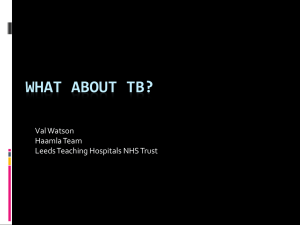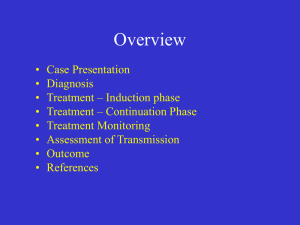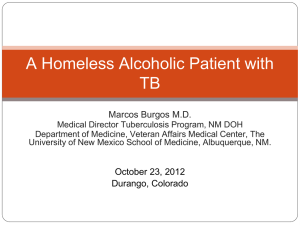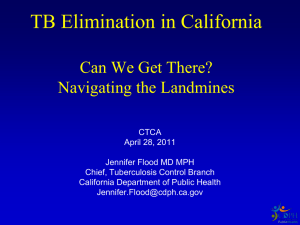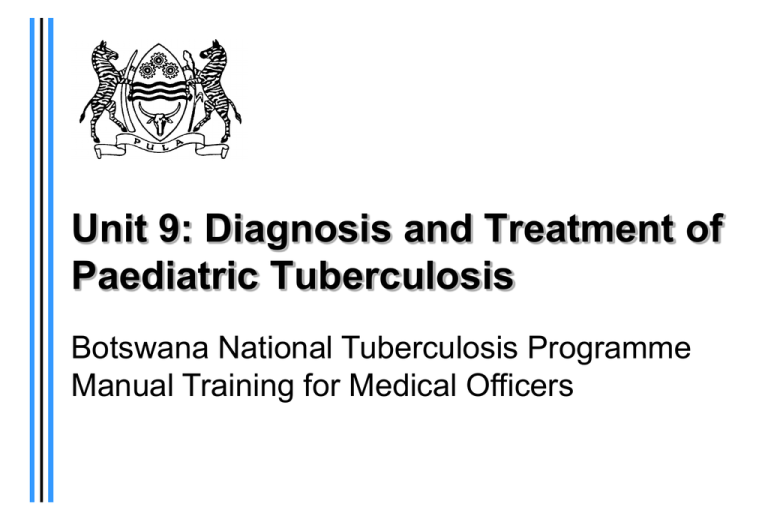
Unit 9: Diagnosis and Treatment of
Paediatric Tuberculosis
Botswana National Tuberculosis Programme
Manual Training for Medical Officers
Objectives
At the end of this unit, participants will be able to:
• Diagnose TB in children
• Discuss the use of the tuberculin skin test
(TST)
• Explain treatment regimens for children
• Explain the interaction between ART and TB
treatment
Unit 9: Diagnosis and Treatment of Paedatric Tuberculosis
Slide 9-2
Worldwide Burden of
Paediatric Tuberculosis
• 8.3 million new cases of TB in 2000*
• 884,019 (10.7%) were in children
• Est. 9 million new cases in 2006**
• 1 million (11%) in children
• varies from 3-25% depending on the country
• 75% occurs in 22 high-burden countries
Sources: *Nelson LJ, et al. Int J Tuber Lung Dis, 2004.
** WHO, 2006.
Unit 9: Diagnosis and Treatment of Paedatric Tuberculosis
Slide 9-3
Botswana Paediatric TB
• In 2000, 12% of all reported TB in Botswana
occurred among children <15 years of age,
though children represented only 2% of smear
positive cases*
•
•
•
•
Reported cases in children 0–9 years of age
1996: 813 (case rate 199/100 000)
2000: 1029 (case rate 229/100 000)
An increase of 15% from 1996-2000
Unit 9: Diagnosis and Treatment of Paedatric Tuberculosis
Source: *B Koosimile, BNTP, 2005.
Slide 9-4
TB Notification Rates by Sex and
Age Group, Botswana 2005
Source: BNTP, 2005.
Unit 9: Diagnosis and Treatment of Paedatric Tuberculosis
Slide 9-5
Diagnosis
Lung Diseases at Autopsy in African
Children Dying from Respiratory Illnesses,
1997-2000, Zambia
Total
HIV-positive
(n=180)
HIV-negative
(n=84)
Acute pyogenic
pneumonia
116(44%)
74 (41%)
42 (50%)
PCP
58 (22%)
52 (29%)
6 (7%)
Tuberculosis
54 (20%)
32 (18%)
22 (26%)
CMV
43 (16%)
40 (22%)
3 (4%)
Interstitial
Pneumonia
30 (11%)
15 (8%)
15 (18%)
Source: Chintu C, et al. The Lancet, 2002.
Unit 9: Diagnosis and Treatment of Paedatric Tuberculosis
Slide 9-6
Key Risk Factors
for TB in Children
• Household contact with newly diagnosed
smear-positive case
• Fewer than 5 years old
• HIV infection
• Severe malnutrition
Source: WHO, 2006.
Unit 9: Diagnosis and Treatment of Paedatric Tuberculosis
Slide 9-7
Young Children Exposed to TB
• Children should be
evaluated for illness
• If not ill and < 5 years old:
INH preventive therapy
• If ill, evaluate for need of
TB treatment
Courtesy of: Hampton G, Lung Health Image Library, 2003.
Unit 9: Diagnosis and Treatment of Paedatric Tuberculosis
Slide 9-8
TB Prevention and Control from
Smear Positive Mother-to-Child
• Infants should take INH prophylaxis for 6
months
• The infant receives BCG after completion of
INH prophylaxis
Unit 9: Diagnosis and Treatment of Paedatric Tuberculosis
Slide 9-9
Recommended Approach to
Dx in Children: Assessment
• Patient history
• Contact to PTB+
• Symptoms consistent
with TB
•
•
•
•
Clinical Exam
TST
Investigations for PTB and EPTB
HIV test
Source: WHO, 2006.
Unit 9: Diagnosis and Treatment of Paedatric Tuberculosis
Slide 9-10
Diagnosis of TB in
HIV-Infected Children
• TST less reliable (false-negatives)
• More extrapulmonary disease- harder to
diagnose
• Broader differential diagnosis with poor tests
• Culture yield- similar to non-HIV-infected
children
Unit 9: Diagnosis and Treatment of Paedatric Tuberculosis
Slide 9-11
Symptoms of
Pulmonary TB in Children
• Clinical manifestations may include:
•
•
•
•
•
•
Chronic cough not improving and present for 2-3 weeks
Night sweats
Fever of > 38 degrees for 2 weeks
Weight loss or failure to thrive
Fatigue*
Blood-streaked sputum
• Shortage of signs and symptoms relative to chest
radiograph findings
Unit 9: Diagnosis and Treatment of Paedatric Tuberculosis
*Source: Marais B, et al. Pediatrics, 2006.
Slide 9-12
Radiographic Manifestations
of Pulmonary TB in Children
• Prominent hilar and/or mediastinal adenopathy
(not always discernable on plain radiographs)
• Any lobe of lung involved; 25% multilobar
• Collapse-consolidation or segmental pattern
common
• Obstructive signs/symptoms with
endobronchial lesions
• Not contagious
Unit 9: Diagnosis and Treatment of Paedatric Tuberculosis
Slide 9-13
Unit 9: Diagnosis and Treatment of Paedatric Tuberculosis
Source: Botswana-Baylor Children’s Slide 9-14
Clinical Centre of Excellence
Bacteriological Confirmation
• If sputum can be obtained, 3 samples should be
sent for smear microscopy
• Perform gastric aspirate smear and culture
• Perform sputum induction
TEST
SENSITIVITY
AFB smear – gastric aspirate
5-10%
Mycobacteria culture – gastric aspirate
0-40%
Mycobacteria culture – infants
Up to 75%
Source: Botswana-Baylor Children’s
Clinical Centre of Excellence
Unit 9: Diagnosis and Treatment of Paedatric Tuberculosis
Slide 9-15
Triad Approach
• Contact with a case +
• Positive TST +
• Consistent clinical and/or radiographic
evidence
THIS IS HIGHLY SUGGESTIVE OF TB
Unit 9: Diagnosis and Treatment of Paedatric Tuberculosis
Slide 9-16
Differential Diagnoses
of Pulmonary TB (1)
•
•
•
•
•
Bacterial pneumonia
Lymphocytic interstitial pneumonitis (LIP)
Pneumocystis carinii (jeroveci) pneumonia
Bronchiectasis
Others
• Fungal pneumonia
• Pulmonary lymphoma
• Pulmonary Kaposi’s Sarcoma
Unit 9: Diagnosis and Treatment of Paedatric Tuberculosis
Slide 9-17
Differential Diagnoses
of Pulmonary TB (2)
•
•
•
•
•
•
•
Asthma
Cardiac disease
Severe gastro-oesophageal reflux
Aspirated foreign body
Pertussis
Cystic fibrosis
Bronchiectasis
Unit 9: Diagnosis and Treatment of Paedatric Tuberculosis
Slide 9-18
Extra-Pulmonary TB: Signs (1)
• Non-painful, enlarged cervical
lymphadenopathy without fistula formation
• Meningitis not responsive to antibiotic
treatment
• Distended abdomen with ascites
• Pleural effusion
• Gibbus deformity of the spine
Unit 9: Diagnosis and Treatment of Paedatric Tuberculosis
Slide 9-19
Extra-Pulmonary TB: Signs (2)
• Pericardial effusion
• Bone or joint swelling
• Signs of tuberculin
hypersensitivity, such as
erythema nodosum
• Subacute CNS disease,
such as change in behaviour progressing to
seizures or coma
Courtesy of: Merck & Co., Inc. 2006.
Unit 9: Diagnosis and Treatment of Paedatric Tuberculosis
Slide 9-20
Time from Infection to Disease
•
•
•
•
•
•
Miliary and Meningeal
Intrathoracic
Lymph node
Pleural effusion
Skeletal
Renal
2 – 6 months
2 – 12 months
2 – 12 months
3 – 12 months
6 months – 2 years
1 – 5 years
Source: Botswana-Baylor Children’s
Clinical Centre of Excellence
Unit 9: Diagnosis and Treatment of Paedatric Tuberculosis
Slide 9-21
TB Cervical Lymphadenitis
Most common
form of extrathoracic TB
Courtesy of: B. Marais, Stellenbosch University
Unit 9: Diagnosis and Treatment of Paedatric Tuberculosis
Slide 9-22
Lymphadenitis Caused by
Mycobacterium Tuberculosis
• Often unilateral, sometimes bilateral
• Chest x-ray usually normal
• Usually non-tender, enlarged, fixed, matted
nodes
• Absence of systemic findings
• Often progress and “break down”:
suppuration, sinus tracts
• Major differential diagnosis = malignancy
Unit 9: Diagnosis and Treatment of Paedatric Tuberculosis
Source: Botswana-Baylor Children’s
Clinical Centre of Excellence
Slide 9-23
Tuberculous Meningitis
• Inflammation of the meninges as a result of
infection with M. tuberculosis
• Presents with headache, fever, irritability,
convulsions, altered mental status
• High-pitched cry
• Bulging fontanelle
• Suspected clinically & confirmed with CSF
Unit 9: Diagnosis and Treatment of Paedatric Tuberculosis
Slide 9-24
Classic Findings in
Cerebrospinal Fluid
VIRAL
BACTERIAL
TB
CELLS
0-500
5-10,000
10-500
DIFFERENTIAL
Lymph
Polys
Lymph
PROTEIN (g/d1)
20-60
20-400
50-5,000
GLUCOSE
(mg/d)
30-80
<20
20-50
Source: Botswana-Baylor Children’s
Clinical Centre of Excellence
Unit 9: Diagnosis and Treatment of Paedatric Tuberculosis
Slide 9-25
CT Scan/MRI Findings in
Meningeal (CNS) Tuberculosis
•
•
•
•
•
Basilar enhancement
Hydrocephalus (communicating)
Vasculitis
Infarct
“Paradoxical” tuberculomas-- while on
ultimately successful chemotherapy
• Ring-enhancing lesions, single or multiple
Unit 9: Diagnosis and Treatment of Paedatric Tuberculosis
Source: Botswana-Baylor Children’s
Clinical Centre of Excellence
Slide 9-26
Disseminated (Miliary)
Tuberculosis in Childhood
• Usually slow, subtle appearance, but may
show rapid progression
• CXR usually normal early, then classic miliary
appearance
• Other common features: hepatosplenomegaly,
lymphadenopathy, cutaneous lesions
• TST negative in up to 50% of cases
Source: Botswana-Baylor Children’s
Clinical Centre of Excellence
Unit 9: Diagnosis and Treatment of Paedatric Tuberculosis
Slide 9-27
Unit 9: Diagnosis and Treatment of Paedatric Tuberculosis
Source: Botswana-Baylor Children’s
Clinical Centre of Excellence
Slide 9-28
What Do You See?
© Slice of Life and Suzanne S. Stensaas
Unit 9: Diagnosis and Treatment of Paedatric Tuberculosis
Slide 9-29
What Do You See?
© Slice of Life and Suzanne S. Stensaas
Unit 9: Diagnosis and Treatment of Paedatric Tuberculosis
Slide 9-30
Tuberculous Pleural
Effusion in Pediatrics
• Primarily in adolescents
• Uncommon before age
five
• Rare before age two
• Usually unilateral, but
can be bilateral
• Usually presents with:
fever, chest pain, SOB
Source: Marais B, Stellenbosch University
Unit 9: Diagnosis and Treatment of Paedatric Tuberculosis
Slide 9-31
Unit 9: Diagnosis and Treatment of Paedatric Tuberculosis
Botswana-Baylor Children’s
Clinical Centre of Excellence
Slide 9-32
Investigations for
Suspected EPTB
Site
Practical approach to diagnosis
Peripheral lymph nodes
(especially cervical)
Lymph node biopsy or fine needle aspiration
Miliary TB (e.g. disseminated)
Chest X-ray and lumbar puncture (to test for
meningitis)
TB meningitis
Lumbar puncture (and computerized tomography
where available)
Pleural effusion (older children
and adolescents)
Chest X-ray, pleural tap for biochemical analysis
(protein and glucose concentrations), cell count
and culture
Abdominal TB (e.g. peritoneal)
Abdominal ultrasound and ascitic tap
Osteoarticular
X-ray, joint tap or synovial biopsy
Pericardial TB
Ultrasound and pericardial tap
Unit 9: Diagnosis and Treatment of Paedatric Tuberculosis
Slide 9-33
Tuberculin Skin Test (TST)
• Latent TB uncommon in children, therefore a
positive skin test is more likely to represent
recent infection and the presence of TB
disease
• Used in tandem with other diagnostic tests in
children
• Mantoux method is recommended test
Unit 9: Diagnosis and Treatment of Paedatric Tuberculosis
Slide 9-34
Applying the TST
(PPD or Mantoux Test)
• TST useful in young
children who have low
prevalence of latent TB
infection
• Placed by intradermal
injection similar to BCG
application
Courtesy of: Knobloch G, CDC, 2004
Unit 9: Diagnosis and Treatment of Paedatric Tuberculosis
Slide 9-35
Reading the TST (Mantoux)
A positive reaction
occurs when a cellmediated immune
response to tuberculin
antigens produces firm
swelling at the
intradermal site after
48-72 hours
Unit 9: Diagnosis and Treatment of Paedatric Tuberculosis
Courtesy of:Kopanoff D, CDC, 1969
Slide 9-36
Interpreting the TST
Test
Mantoux
•
•
Risk Status
Reading
Interpretation
Low
≥ 10 mm
Positive
High: HIV+,
malnourished
≥ 5 mm
Positive
Positive Result
Negative Result
Infection with MTB
• No infection with MTB
Does not prove active • Cannot exclude active TB disease
tuberculosis disease
(20-25% of HIV patients with active
TB have negative TST)
Unit 9: Diagnosis and Treatment of Paedatric Tuberculosis
Slide 9-37
Incorrect TST Results
False Negative
• Incorrect placement
• Incorrect reading
• HIV infection and other
immunosuppression
• Viral Infections, e.g.
measles
• Vaccinated with live
viral vaccines (w/in last
6 weeks)
Unit 9: Diagnosis and Treatment of Paedatric Tuberculosis
False Positive
• Incorrect interpretation
of test
• Infection with M. bovis
or MOTT
• Recent BCG
Slide 9-38
BCG Vaccination
• BCG vaccine prevents severe forms of TB in
infants (up to 85% reduction) and is
recommended for newborns
• TB meningitis
• Miliary TB
• Negligible effect on TB epidemiology
• Does not prevent infection
• Little effect on reactivation disease
Unit 9: Diagnosis and Treatment of Paedatric Tuberculosis
Slide 9-39
BCG Dosages
Age
Dose
Site
At birth
0.05 ml
Intra-dermal
Above 1 year
0.10 ml
Intra-dermal
Unit 9: Diagnosis and Treatment of Paedatric Tuberculosis
Slide 9-40
BCG Vaccination in Children
Administer BCG
vaccine
Do not administer BCG
vaccine
Known HIV negative children
Known HIV positive children
with or without signs or
symptoms of HIV infection
Children of unknown HIV status
without signs or symptoms of
HIV infection, regardless of HIV
status of mother
Children of unknown HIV status
with signs or symptoms of HIV
infection present, regardless of
HIV status of mother
Unit 9: Diagnosis and Treatment of Paedatric Tuberculosis
Slide 9-41
Normal Reaction
Course to BCG Vaccination
At
vaccination
Approximately
3 wk post-vacc
Approximately
1 yr post-vacc
Approximately
6 wk post-vacc
Courtesy of: Kim SJ, Korean Institute of Tuberculosis, 2001
Unit 9: Diagnosis and Treatment of Paedatric Tuberculosis
Slide 9-42
Complications of BCG
•
•
•
•
Swelling of lymph nodes adjacent to vaccination site
Subcutaneous abscess in babies
Excessive ulceration
Local ulcers and BCG adenitis persisting for more
than 8 weeks
• Note: Routine follow-up of infants is recommended
for early identification and treatment of any BCGrelated complication
Unit 9: Diagnosis and Treatment of Paedatric Tuberculosis
Slide 9-43
Interaction of BCG Vaccines
with the Tuberculin Skin Test
• 79% of vaccinated children ages 3-60 months did not
react to a TST (MMWR 1997)
• Most non-infants who get one or more BCG
vaccinations will react to a TST (usually <15 mm),
but effect wanes over 5 – 10 years
• Outside infancy, “positive” TST more likely to indicate
infection with M. tuberculosis than be residual from
BCG
Unit 9: Diagnosis and Treatment of Paedatric Tuberculosis
Source: Lockman S, et al., Int J Tuberc Lung Dis, 1999.
Slide 9-44
HIV Testing
• In Botswana, HIV testing is part of the
diagnostic work-up for ALL TB suspects
(including children)
• In HIV positive children:
• Lymph node and pulmonary TB are Clinical Stage 3
• EPTB other than lymph node is Clinical Stage 4
Unit 9: Diagnosis and Treatment of Paedatric Tuberculosis
Slide 9-45
Impact of HIV on Diagnosis and
Management of TB in Children
• HIV makes diagnosis and management of TB in
children more difficult for the following reasons:
• Other HIV-related disease, such as lymphocytic interstitial
pneumonitis, may present in a similar way to PTB or
miliary TB
• Interpretation of tuberculin skin testing and CXR is less
reliable
• Pill burden of TB treatment and ART can be difficult for
children to tolerate
• Drug-drug interactions between rifampicin and NNRTIs
and PIs
Unit 9: Diagnosis and Treatment of Paedatric Tuberculosis
Source: WHO, 2003
Slide 9-46
Anti-tuberculosis
Drug Dosing in Children
R 150 mg
Average dose mg/kg/day
(Range)
10 (8-12)
H 100 mg
5 (4-6)
Z 500 mg
25 (20-30)
E 100 mg
15 (15-20)
S IM
15 (12-18)
Unit 9: Diagnosis and Treatment of Paedatric Tuberculosis
Slide 9-47
Recommended Treatment
Regimens for Children
• Category I
• Children with severe disease, such as
disseminated TB: 2HRZE/4HR
• Children with TB meningitis: 2SHRZ/4HR
• Category II
• 2SHRZ/1HRZ/5HR
• Category III
• 2HRZ/4HR
Unit 9: Diagnosis and Treatment of Paedatric Tuberculosis
Slide 9-48
Role of Adjuvant Steroid Therapy
• TB meningitis
• 2mg/kg/day for 4 weeks and then taper over 6 weeks
• TB pericarditis
• 2mg/kg/day for 4 weeks then 1mg/kg/day for 4weeks then
taper for 6 weeks
• Massive lymphadenopathy with airway obstruction
• 2mg/kg/day for 4 weeks then taper over 6 weeks
Unit 9: Diagnosis and Treatment of Paedatric Tuberculosis
Slide 9-49
Tuberculosis in Children:
Drug-Resistance
• Usually must link the child with an adult case
to identify it
• Adults with drug-resistant TB are as
contagious as those with susceptible disease
• Disease expression in children the same as
with susceptible strains
• Children tolerate and respond well to secondline drugs
Source: Botswana-Baylor Children’s
Clinical Centre of Excellence
Unit 9: Diagnosis and Treatment of Paedatric Tuberculosis
Slide 9-50
Treating the Dually Infected Child
• Use the same guidelines for initiating ART for
children with tuberculosis as you would for any
HIV+ child
• Cotrimoxazole should always be given
Unit 9: Diagnosis and Treatment of Paedatric Tuberculosis
Slide 9-51
Cotrimoxazole Dosing
Age/
Recommended Suspension
(5ML syrup =
weight of daily dose
200mg/40mg)
child
6 weeks to
6 months
(<5kg)
100mg
sulfamethoxazole/
20mg trimethoprim
6 months to 200mg
5 years (5- sulfamethoxazole/
15kg)
40mg trimethoprim
6 to postpubertal
400mg
sulfamethoxazole/
80mg trimethoprim
Unit 9: Diagnosis and Treatment of Paedatric Tuberculosis
Child
tablet
(100mg/
20mg)
Single
strength adult
tablet
(400mg/80mg)
2.5ml
One
tablet
5ml
Two
tablets
Half tablet
10ml
Four
tablets
One tablet
Slide 9-52
ART and Rifampicin-Based
TB Therapy for Children >3 years
• Efavirenz + 2 nucleosides
• Choice of nucleosides
• Zidovudine + lamivudine (AZT/3TC)
• Alternate: stavudine + lamivudine (d4T/3TC)
• d4T should be used in place of AZT if baseline anaemia
is present
Unit 9: Diagnosis and Treatment of Paedatric Tuberculosis
Slide 9-53
ART and Rifampicin-Based
TB Therapy for Children <3 years
• Nevirapine + 2 nucleosides
• Choice of nucleosides
• Zidovudine + lamivudine (AZT/3TC)
• Alternate: stavudine +lamivudine (d4T/3TC)
• d4T should be used in place of AZT if baseline anaemia
is present
Unit 9: Diagnosis and Treatment of Paedatric Tuberculosis
Slide 9-54
Key Points (1)
• TB is a significant cause of morbidity and
mortality in children in Botswana
• Use INH preventative treatment to prevent TB
disease in children <5 years
• Prevent serious TB disease in newborns with
BCG
Unit 9: Diagnosis and Treatment of Paedatric Tuberculosis
Unit 9: Diagnosis and Treatment of Paediatric TB
Slide 9-55
Key Points (2)
• In children <10 years old
• Smear positive PTB unusual
• Diagnosis made on clinical and suggestive
evidence (CXR, TST, physical findings)
• Severe forms of EPTB are frequent
• HIV makes diagnosis and management of TB
in children more difficult
Unit 9: Diagnosis and Treatment of Paedatric Tuberculosis
Slide 9-56



